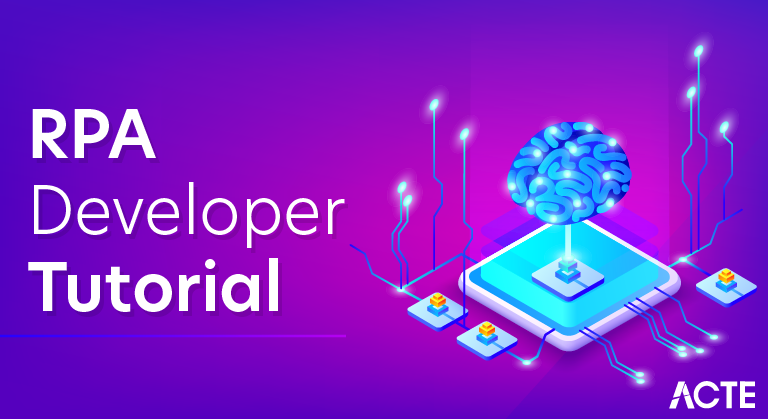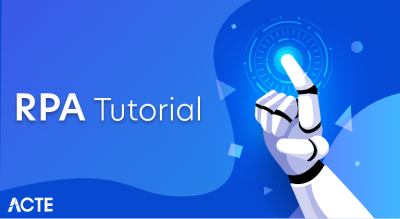
RPA refers to Robotic Process Automation. The technology deal with the method of automating compound and redundant business responsibilities using ML and AI algorithms. It provides software capabilities to allow the machine to work on any applications or website in the same manner as humans. If you’re looking ahead to build your career in RPA Jobs, then below we have mentioned the information regarding RPA developer profile which will help you to acknowledge and make your career successful.
Robotic Process Automation
Robotic Process Automation or RPA (nowadays for everything there is an acronym) is an emerging form of business process automation, which focuses on automating the repetitive tasks which are currently performed by a human. RPA is different from the traditional way of programming which requires a lot of back end coding.
Why RPA?
RPA is not part of an organization’s IT infrastructure. Instead, it belongs to the top of the whole organization’s IT infrastructure. In an IT environment, most of the business processes are not smart and intelligent. Many of them are dependent on multiple IT systems, which rarely interact with each other. Such types of tasks are repetitive, time-consuming, and labor-intensive for human beings. With the Robotic Process Automation, it takes large IT transformation plans and implementation process to automate those types of repetitive, time-consuming, and rule-based tasks more quickly, accurately, and tirelessly, compared to a human being.
RPA technology uses bots that interact with web applications, web sites, excel worksheets, and emails to automate the tasks just like a human. RPA is currently the most efficient automation solution, and it helps human beings to focus on those tasks which require emotional intelligence, reasoning, judgement, and interactions with the customers, rather than just doing repetitive tasks.
Architecture
- Bot Development: The development and deployment of software bots is the foundation of RPA architecture. The repetitious, rule-based processes are automated by these bots. The architecture often comprises a studio or environment for bot creation, where programmers create and set up the bots to imitate human behavior and communicate with other systems.
- Control Centre: To administer and keep an eye on the deployed bots, the design incorporates a centralized control center. Administrators may plan and coordinate bot actions using the control center’s dashboard or interface, track performance, and handle exceptions or failures. It ensures visibility into the automation processes and allows for effective bot management.
- Integration Layer: The RPA structure includes an integration layer that makes it less difficult for the bots and the goal applications or systems they address to communicate. This layer often consists of adapters, connectors, and APIs that facilitate clean integration with a variety of technologies, including net-based totally apps, CRM platforms, and ERP systems.
- Security and compliance: The RPA architecture places a sturdy emphasis on those problems. To assure that only authorized users can get admission to and use the bots, it incorporates features like user authentication, get admission to limits, and encryption. Audit logs and tracking structures are also used to maintain music of bot interest and make certain that regulatory and records safety standards are being met.
- Scalability and Resilience: Scalability and resilience are key additives of the RPA structure. Organizations may develop their automation initiatives as essential by deploying several bots to handle diverse sports simultaneously. To make certain the continuing functioning of bots and reduce downtime, the architecture may include capabilities like load balancing, failover techniques, and disaster restoration competencies.
Example of RPA
Consider the following Invoice Processing Business process.
How to become an Expert RPA Developer?
As RPA gains momentum in the global and national markets, there is no doubt that the demand for RPA developers will be off the roof. In fact, a recent search on ‘Robotics Process Automation’ on LinkedIn’s job site produced 2,158 open positions. The number further increased with a search on RPA. This clearly points to the fact that becoming an expert RPA developer is a wise choice for the future. However, it is easier said than done. RPA, as a technological disruption, is relatively in its nascent stage as compared to other technologies. Invariably, understanding what it takes to be an expert RPA developer and then realizing each of those capabilities is hard work. On the bright side, all the hard work is definitely worth it when you look at the benefits, especially monetary, it comes along with.
Our aim here is to help budding RPA developers understand what they set out for. We seek to highlight the roles, the skills, the courses they can take up and finally what fruits they can expect.
RPA Implementation Methodology
Process Identification and Prioritisation:
Start by identifying and ranking the processes that are amenable to automation. Look for jobs that can be automated using RPA that are rule-based, repetitive, and have a high number of transactions. Think about things like complexity, the effect on productivity, mistake rates, and possible ROI.
Process Evaluation:
In order to comprehend the present condition of the listed processes, thoroughly evaluate them. Keep a record of the steps taken, system interactions, data needs, and exceptions. Examine the automatability of each process and note any possible difficulties or dependencies.
Design and Configuration:
Create the RPA solution when a process has been chosen for automation. Identify the most effective automation strategy, including the RPA platforms or solutions that should be used. Create software bots that can execute tasks like data entry, system navigation, and calculation mimicking. Rules, business logic, and exception handling should be defined to enable accurate and effective automation.
Development and Testing:
Create and test software bots to develop the automation solution. This entails developing automation procedures, connecting them with the target systems, and putting the required validations in place. Conduct extensive testing to make sure the bots work as intended and adhere to the specifications. Check for different circumstances, such as exceptions, system flaws, and data variances.
RPA Implementation Best Practises:
- To evaluate and confirm the efficacy of RPA in a controlled setting, start with a small-scale pilot.
- To ensure correct automation and take care of particular requirements, include process owners and subject matter experts at every stage of the implementation.
- Put adequate access restrictions, encryption, and audit trails in place to give security and compliance issues a priority.
- Evaluate and assess the performance of deployed bots over time to spot areas that might want optimization.
- To guarantee a successful adoption of RPA and collaboration with software bots, offer thorough training and assistance to your staff.
- By frequently evaluating and optimizing automated processes to maximize effectiveness and ROI, you can promote a culture of continuous improvement.
- To efficiently manage and maintain the automation technology, create a specific RPA governance structure.
Skills Required:
- Strong Problem-Solving and Analytical Skills
- Experience with one or more RPA technologies (e.g. UiPath, Automation Anywhere, Blue Prism)
- At least 2 to 4 years of professional experience in programming (including scripting /coding), SQL and relational databases, and application development
- Experience with Process Analysis, Design, and Implementation, Business and Technical requirements, Problem-Solving, and System(s) Testing, including UAT and Bug fixes
- Should be able to Prioritise and manage Multiple Portfolios
- Basic understanding of Lean Six Sigma process methodologies
RPA Developer: Process Designer Salary
INDIA
- For Freshers or people with experience of 0-2 years – INR 6,00,000 to 8,00,000 per year
- For Senior Role having experience of 2-6 years – INR 9,00,000 to 15,00,000 per year
USA
Average Salary Ranges from $ 84,000 to $ 132,000 per year
Uses of RPA:
1. Data Entry and Migration:
RPA can automate manual data entry into systems and make it easier to move data across databases or applications.
2. Report Generation:
RPA is capable of producing reports by gathering information from many sources, carrying out computations, and structuring the outcomes into standardized reports.
3. Processing of Invoices:
RPA can speed up the workflow for processing invoices, which includes extracting data, validating it, comparing it to purchase orders, and creating payment records.
4. Customer Onboarding:
By gathering data, doing background checks, and adding data to pertinent systems, RPA may automate the process of onboarding new clients.
5. HR and Employee Management:
RPA may help automate a number of HR tasks, including hiring new employees, managing leaves of absence, monitoring time, and evaluating employee performance.
6. Financial Reconciliation:
RPA can quickly reconcile accounts by automatically comparing financial data from various systems, finding inconsistencies, and comparing them.
7. IT Service Desk Support:
RPA may perform common IT support activities like password resets, user account management, and ticket routing, freeing up IT staff to work on more complicated problems.
8. Compliance and Audit:
By automating data validation, report production, and the construction of an audit trail, RPA may assist assure compliance by lowering the risk of mistakes and assuring proper record-keeping.
9. Claims Processing:
RPA can speed up and accurately handle insurance claims by automating data extraction, verification, and adjudication.
10. Client Service and Support:
By automating answers to commonly asked questions, directing client inquiries, and obtaining customer data from various systems, RPA helps improve customer service.
Role & Responsibilities
Let’s start the discussion by understanding what are the major roles and responsibilities of an RPA developer. As RPA is all about end to end implementation of robotics and artificial intelligence to build automated systems, an RPA developer does exactly that. Confused, what this means? To put it simply, an RPA developer is responsible for creating, designing, developing and implementing RPA systems. The RPA developer’s role also entails monitoring feedback post implementation, to ensure seamless execution. Finally, support and maintenance work to resolve bugs is also undertaken by RPA developers.
While these are the primary responsibilities of RPA developers, they may adapt to match the organizational structure. On the one hand, an RPA developer could be responsible for the end to end management, taking care of every step on the way. While such a role definition ensure consistency, however, it hinders scalability. On the other hand, some organizations recruit separate RPA developers for different parts of the RPA lifecycle. Each one is responsible for a distinct role, making it easier to scale the operations.
Tools for Robotic Process Automation:
The following 3 factors should be considered while choosing an RPA tool:
- Functionality and capabilities: Consider the RPA tool’s capabilities and functionality. Think about if it complies with your organization’s unique automation needs, such as data extraction, application integration, cognitive capabilities, attended automation, and unattended automation.
- Scalability and Flexibility: Take into account the RPA tool’s capacity for expansion and adaptability. Check to see if it can manage the complexity and volume of your automation requirements. Such functions as load balancing, multi-bot management, and the capacity to expand automation across many systems and processes are to be sought.
- Reliability and Stability: Finding an RPA tool that is dependable and stable is important. Take into account the vendor’s standing, performance history, and client testimonials. Check to see if the tool has a robust community and support network that can offer help and timely updates.
Tools Used in RPA:
1) WorkFusion:
Robotic process automation (RPA) platform called WorkFusion combines robotic automation and AI capabilities. Process automation, cognitive automation, and analytics are all included in the wide range of automation solutions it provides. For improved automation and data extraction, WorkFusion offers a visual design studio, sophisticated document processing, and machine learning capabilities.
2) Kofax:
Kofax is an RPA solution with a focus on document processing and intelligent automation. Natural language processing, cognitive capture, and clever OCR are among its characteristics. Kofax offers a centralized platform for interacting with diverse systems, automating end-to-end processes, and using machine learning for data extraction and decision-making.
3) UiPath
The thing that excites Choudhary the most about her job is knowing she’s saving people time and energy so that they can do more productive work and contribute more to the organization.
“Generally, one person works only in one domain,” she adds. “It really excites me that my bots are skilled to do jobs in all domains, like HR, IT, finance, support, etc., which takes my one-time effort and does work all the time. Also, I get to learn a lot about how people work in each domain, and it gives me exposure to various areas to better understand how the company works.”
Colleague Mohammed agrees. “Getting to know different processes in an organization and finding ways to simplify processes using software bots” motivates him to go to work every day.
Both RPA developers enjoy working at Automation Anywhere and have been recognized by business users, managers, and teammates. “People are very helpful here,” Choudhary says. She knows that at any time, she can reach out to a teammate, whether she knows that person or not, and they’re always ready to help.
Additionally, people go to her for help, and she finds it not only rewarding to be able to help them, but also to get to know more of her teammates. “It feels like working in a family where we can reach out to anyone as everyone works for everyone. There is no client and project and such,” she says.
“The business users are very supportive, kind, and helpful,” she adds. “They have always appreciated whenever we have delivered their bot and have helped us immediately whenever we needed their input.”
Benefits of RPA
- To avoid human errors and to reduce human efforts.
- To save time and improve productivity, accuracy, and consistency.
- Enhance the business analytics and easy standardization of workflow.
- To have a frictionless delivery of tasks.
- Complete Audit trail for any kind of compliance purposes.
- Cost reduction.
Process
Robotic Process Automation for Invoice Processing can be summarized in 5 major steps.
- Extracting Invoice: RPA will extract the PDF copies of Invoices from Email, Workflow, or from a dedicated folder, etc.
- Reading Invoices: Once the invoices are extracted, the Robot will read the specific fields in the Invoices that need to be updated in the ERP.
- Verification of Invoices: RPA will verify the Invoice details like the Company code, Supplier number, VAT etc with the database and if verification passes it moves to the next step.
- Inputting Invoice details in ERP: Once the required information is gathered and verified from the Invoices, RPA robot will open the ERP and key in all the fields that need to be filled. It can be in SAP, Oracle or whatever ERP your company uses.
- Confirmation: Once the data has been successfully inputted in the ERP system, the robot will provide confirmation. Either it can be over email for each Invoice or a consolidated email for all posting. If require a report with all the posting details in excel etc. it can be provided, it’s highly customizable however the organization wants.
processes for RPA.
- Rule Bases Process: Select only the Rule-based process for RPA. Rule-based process are those where a series of simple “If…then” logic can be applied without involving any human decision.
- Stable Process : Identify a process which is been performed in the same way for a period not less than 6 months. Also, ensure there are no frequent changes expected in the process in the near future.
- Standard Inputs : Ensure the identified Stable Rule-Based Process always should have Standard Input, else it’s not a suitable process for RPA.
These are very basic 3 Golden Rules to qualify a process for RPA. In addition to this, to get a better ROI also make sure the identified process qualifies the below checks too.
- Repetitive Manual Process : Its ideal to select repetitive manual process for automation to gain FTE reduction cost benefit.
- High Volume : Also the process should quantify in terms of high volume to gain a better return on investment for automation.
This helps you in identifying the right process for robotic process automation.
Rpa Myths:
- RPA completely replaces human workers:
One prevalent misconception is that RPA will completely supplant human employees. RPA is intended to automate routine, rule-based processes, freeing up human workers to concentrate on more complicated, value-added jobs. RPA collaborates with people, enhancing their capacities and increasing productivity. - RPA requires extensive coding skills:
RPA adoption demands substantial coding abilities, according to a different urban legend. Modern RPA technologies frequently include user-friendly interfaces and visual design environments that enable business users to construct automation workflows without considerable coding skills, however, some amount of technical understanding is beneficial. - The implementation of RPA is costly and time-consuming:
RPA installations are thought to be expensive and time-consuming. Although RPA has expenses like licensing fees and infrastructure needs, the return on investment from higher productivity, fewer mistakes, and more efficiency frequently overcomes the original expenditure. RPA installations can also be carried out gradually, beginning with modest pilots and escalating over time.
RPA can be used to generate automated bills, invoice, telephone service, etc. which are used across industries irrespective of their software exposure.
There are different types of career options are available for RPA developer in the IT industry. Some of them are given below:
- RPA Consultant
- RPA Administrator
- RPA Engineer
- RPA Business Analyst
Conclusion:
Thus, due to the various benefits of RPA, its utilization is gradually increasing in the market worldwide. Most of the organizations are already implementing the RPA technology, as it optimizes the cost and frees the other resources. It is a cost-effective technique and also has non–financial benefits such as it consists of more accurate and consistent processes, which are less prone to errors. Nowadays, most of the organizations are using RPA for testing the particular application and eliminating the old testing tools due to its limitations. For example, selenium, this automation tool is limited to only to a single browser. If the other part of the application has to be tested, then it is required to integrate it with other tools, but with RPA any part of the system can be tested with a single tool.





